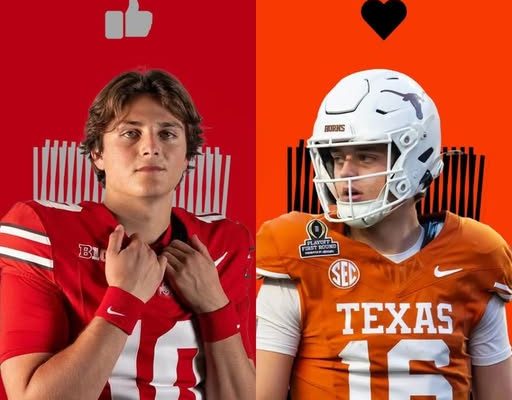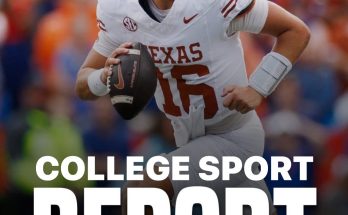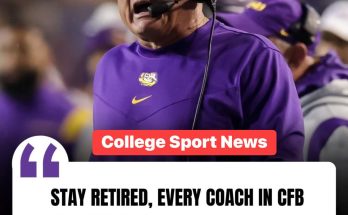The world of college football is built on anticipation, legacies, and the constant hunger for the next great quarterback who can carry a program into championship contention. Few positions in all of sports hold the same weight as quarterback does in football, particularly at the collegiate level where a single player can dramatically alter the trajectory of a team’s season, or even an entire era. In 2025, two names dominate conversations when it comes to the future of the quarterback position: Julian Sayin and Arch Manning. Both are young, talented, and destined to carry enormous expectations. Both are stepping into the spotlight, but as history has taught us time and again, only one can truly rise above the other in the way the sport demands.
Julian Sayin, a product of Carlsbad High School in California and one of the most polished quarterback prospects of his generation, was highly sought after by nearly every major program in the nation. From the moment he first put on a helmet, scouts and analysts were struck by his poise, decision-making, and uncanny ability to deliver precise passes under pressure. He represents the modern evolution of the quarterback position: cerebral yet athletic, calm yet aggressive, and capable of leading an offense that demands speed and versatility. His journey to this moment has been about proving that he is not simply another five-star recruit but a generational player who can live up to the immense billing placed upon him.
On the other hand, Arch Manning has had to live with a last name that carries both privilege and pressure in equal measure. As the nephew of Peyton and Eli, and the grandson of Archie, football was not merely a choice but something ingrained into his very identity. Every snap he has ever taken, from high school onward, has been dissected under a microscope larger than perhaps any high school quarterback in history. It is impossible to discuss him without mentioning the Manning legacy, a burden and blessing that he has learned to embrace. Yet Arch Manning is not just a name—he is a player who has earned his place among the most exciting young quarterbacks in college football. With a strong arm, impressive mobility, and the football IQ expected of someone with his lineage, Arch represents continuity between the past and the future of the position.
The collision course between Sayin and Manning is not simply about their individual talents but about the roles they occupy in the broader narrative of the sport. College football thrives on rivalries, comparisons, and debates over who deserves to be considered the best. In many ways, Sayin and Manning embody two different archetypes of greatness. Sayin is the technician, the strategist who wins through precision and preparation. Manning is the heir to a football kingdom, playing not only for himself but for the preservation of a legacy that has defined NFL Sundays for decades.
As both step into their college careers, the question becomes which of them will truly rise to define this era. The competition will not only be about physical skills but about intangibles. The quarterback position is as much about leadership as it is about arm strength. Sayin, for instance, has shown a unique maturity even in high school, taking command of the huddle and making complex reads with an ease that belied his age. His teammates speak about his ability to instill confidence in those around him, a quality that often separates good quarterbacks from great ones. Manning, meanwhile, carries an aura that few young athletes possess. The Manning name automatically draws respect, but Arch has gone beyond reputation. His ability to perform in high-pressure games in high school, and the way he has handled relentless media scrutiny, suggests that he is prepared for the weight of expectations that college football will throw at him.
Another layer of intrigue lies in how their respective programs will shape their journeys. The quarterback is not a solo act; he is the centerpiece of a system designed to maximize his strengths and mask his weaknesses. Coaching, play calling, and supporting cast will all determine how each of these players adapts to the next level. Sayin’s decision to commit to a powerhouse program ensures that he will be surrounded by elite talent, but it also means he will face competition from equally talented teammates and pressure to deliver immediately. Manning, meanwhile, chose a path that balanced his development with the opportunity to eventually take the reins as the unquestioned starter. These contrasting environments could play a pivotal role in determining who ultimately emerges as the face of college football.
When evaluating who may rise above the other, it is also important to look at how the modern game values different skill sets. The college game, much like the NFL, has shifted toward quarterbacks who can extend plays with their legs, manipulate defenses with their mobility, and thrive in fast-paced offensive schemes. Sayin fits neatly into this mold. His quick release and accuracy make him dangerous in a spread offense, while his athleticism allows him to escape collapsing pockets and turn broken plays into gains. Manning, though perhaps less dynamic as a runner, makes up for it with his football brain and an ability to dissect defenses in a manner that resembles his uncles. He is a quarterback who thrives in rhythm, with the mechanics and pocket presence to thrive even against elite defensive schemes.
What makes this duel fascinating is that success cannot be measured only in statistics. Quarterbacks are remembered for the moments when everything was on the line: the game-winning drives, the playoff runs, the championships. Sayin may throw for more yards and touchdowns, but Manning might engineer the iconic comeback that etches his name into history. Conversely, Manning may carry the pressure of comparisons to Peyton and Eli, and if he fails to reach their heights, even impressive numbers may not satisfy critics. Sayin has the chance to build his story without such baggage, forging a narrative that is entirely his own.
There is also the human element. Both young men are stepping into the national spotlight at a time when social media amplifies every performance, good or bad. A single poor showing can lead to endless scrutiny, while a highlight-reel play can elevate a player into stardom overnight. How Sayin and Manning handle this constant exposure will go a long way in shaping their careers. Manning has been dealing with this level of attention for years, making him somewhat battle-tested. Sayin, though less accustomed to such scrutiny early in his career, has shown a quiet resilience that suggests he will not be easily rattled.
The story of these two quarterbacks is not yet fully written, but the contours are clear. Both have the talent, the drive, and the circumstances to become stars. But history tells us that when two such players emerge at the same time, one usually finds a way to rise just a little higher. It was that way with Peyton Manning and Ryan Leaf, with Andrew Luck and Robert Griffin III, with Trevor Lawrence and Justin Fields. Both can be successful, but only one becomes the defining face of a generation.
In Sayin’s case, his ceiling lies in his ability to master the intricacies of the modern game. If he can continue to sharpen his reads, expand his comfort in complex offensive systems, and combine his athleticism with consistent execution, he has the chance to be remembered as one of the most precise quarterbacks in the history of the sport. For Manning, the path is about translating his legacy into results. The name has already opened doors, but only performance will keep them open. If he can lead his team to championships and display the same clutch gene that made his uncles icons, he will not only fulfill the family legacy but create one of his own.
In the end, this is not just a battle between two quarterbacks. It is a clash of narratives, of expectations versus potential, of legacy versus individuality. Both Julian Sayin and Arch Manning are stepping into the spotlight, but the unforgiving nature of football dictates that only one can truly rise above as the undisputed star of this era. The journey ahead will be shaped by countless variables—coaching, health, supporting cast, and sheer luck—but what is certain is that fans will watch with bated breath as these two quarterbacks define the next chapter of college football. Whether it is Sayin’s precision or Manning’s pedigree that ultimately triumphs, the sport is richer for their presence, and their duel promises to be one of the defining stories of this generation.



